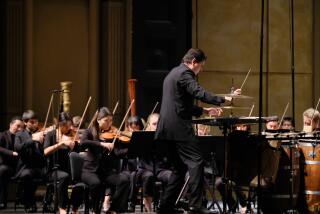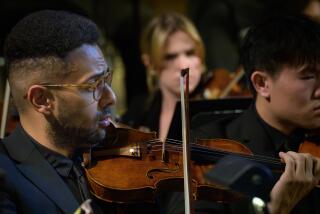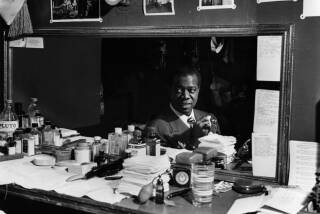NEW YEAR SHOW : KYSER ALUMS IN REUNION OF ‘KOLLEGE’
- Share via
It was late 1942, America was fighting the war against Germany and Japan and the Kay Kyser Orchestra was doing what it did best--entertaining the troops with popular music and pratfall comedy.
The 20-piece big band, known nearly as much for silliness as syncopation, found itself in the California desert outside Indio, where the legendary Gen. George S. Patton was preparing GIs for combat. After the performance, an appreciative Patton decided to offer the orchestra some entertainment of his own.
With a gruff order for everyone to have fun, “Old Blood and Guts” put the musicians and singers in a battalion of tanks and sent them racing over cactus, brambles and whatever else got in the way.
To Patton, the careening tanks may have been an odd and fleetingly amusing sight, but to Jess Bourgeois, one of the band’s original bassists, it was typical of what made the Kyser years so special.
“Let me tell you, it was wild, and it was just like the band to get into something crazy like that,” recalled Bourgeois, now 71. “Patton had on his famous pistols and everything . . . and then letting us race in those tanks. Those were the best times, when we had great music and great times. Those are the moments I remember best.”
There won’t be any tanks when three of the original band members reunite with other players from the big band era for Wednesday’s New Year’s Eve show in Garden Grove, but Bourgeois says there should be some of the old spirit. The band, performing at the Alicante Princess Hotel, will be fronted by singer Harry Babbitt (given the sobriquet “Handsome Harry” by Kyser, who died in 1985) and will perform the old favorites.
During a recent interview, Bourgeois and Babbitt often drifted back to when the Kay Kyser Orchestra had a revered spot on the American music scene next to “swing” giants like the Tommy Dorsey and Benny Goodman bands.
The group was formed in the early 1930s and had much success on radio and on tour with its “Kollege of Musical Knowledge,” a mixture of popular tunes like “Who Wouldn’t Love You” and “On a Slow Boat to China” and gags. Leader James Kern (Kay) Kyser would interrupt the numbers with musical quizzes, often handing out small cash prizes for correct answers. The questions were easy, and the “Old Perfesser,” as Kyser was known, kept it lively.
Kyser often operated as the straight man for a succession of singer-comics, the best known being Ish Kabibble (Merwyn A. Bogue), who peered out from under long hair and bangs and warbled the lyrics to Hit Parade numbers like “Three Little Fishies.” After the gags, the serious singers like Babbitt and Ginny Simms would croon romantically.
Ironically, it wasn’t until the war years that the orchestra really took off, becoming synonymous with efforts to entertain soldiers and foster the unbridled patriotism that swelled everywhere. Kyser was a regular headliner at the Hollywood Canteen, the nightclub reserved for enlisted men returning from combat or awaiting their call.
Babbitt, now 72 and a little broader than in his salad days, recalled that the orchestra played the canteen almost every weekend when not touring, sharing the stage with Hollywood stars who were brought in to charm the doughboys. Bette Davis, Linda Darnell, Lucille Ball and Marlene Dietrich often stopped by.
“Bette Davis used to come in and wait on the tables; all those big names did even the smallest tasks to keep the boys happy,” said Babbitt, a gentle-voiced man who has lived in Newport Beach for several years. “We’d really get up for those performances because we felt it was so important. It was also really important to Kay; he really couldn’t do enough for the GIs . . . he even wore GI fatigue boots when we played.”
Kyser’s dedication was echoed by Bourgeois, who noted that the band leader saved most of it for enlisted men.
“To tell the truth, Kay was really nasty to officers because he felt they always got more than the GIs,” remembered Bourgeois, who lives in Laguna Niguel. “But when it came to the GIs, he did what he could to give them the best of everything.”
The group also routinely went on tour to sell war bonds. A government train took the orchestra across the country, where it played in both large and small auditoriums. Tickets usually were the price of a war bond, Babbitt said, noting that concert-goers often had to buy a $100,000 bond to get a front row seat.
Performances usually sold out in advance, and the size of some of the crowds rivaled the later mega-rock concerts of the 1960s, ‘70s and ‘80s. Babbitt said a show at Soldier Field in Chicago drew more than 100,000 flag-wavers eager for swing. They were also treated to walk-ons by James Cagney, Dick Powell, Fred Astaire, the Marx Brothers and the usual svelte leading ladies.
“It was a once-in-a-lifetime experience, both for the audience and for us,” said Bourgeois.
After the war, Kyser’s popularity took him to Hollywood, where he and the band made more than half a dozen low-cost movies (Babbitt was often the romantic singing lead) while continuing to broadcast concerts every Wednesday over the NBC airwaves. But by 1948, the orchestra’s success began to wane, and Kyser’s health slipped, making it difficult for him to keep up with the rigorous schedule.
The orchestra disbanded in 1949.
“There were several reasons for it,” Babbitt recalled. “Kay’s health made it tough for him, but these also weren’t the best times for big bands. Television began broadcasting (concerts), and people stopped going to the concerts as much . . . there just wasn’t that much money around” to support the groups with their large rosters.
But by then the Kyser orchestra had already become part of American music history. When asked to describe its place, Babbitt was quick to put everything into perspective. The Dorsey and Goodman bands were more accomplished when it came to serious music, he said, but Kyser’s was probably the best at providing full-throttle entertainment.
It all came down to the Kyser philosophy of looking for musicians who could show personality as well as technique. “You couldn’t always play it straight in his bands; you had to have fun,” Babbitt explained. “It was Kay; he was more a cheerleader than anything else, and his players had to get into that.”
Other era musicians say the same. Al Anderson, who played for Kyser, Dorsey and Goodman, said Kyser was much easier to get along with than the other two but was no less demanding about the music’s quality.
“He was a really kind-hearted guy, but he still had some of the best people in the business; it was a good deal all the way around,” said the 62-year-old Anderson, who will play in the reunion show.
Despite the big band sound being out of vogue for several years, Babbitt and Bourgeois have kept busy with an occasional concert and have planned a national tour for late next year. The group decided to form again because of the current resurgence in interest in swing and dance music, especially among younger people.
The reason is obvious to Babbitt: People love to dance, especially when it’s nice and close.
“The kids are finding out that dancing cheek-to-cheek is just about the best way to do it,” he said. “Most of our music asks you to dance that way--it’s romantic all the way.”
More to Read
The biggest entertainment stories
Get our big stories about Hollywood, film, television, music, arts, culture and more right in your inbox as soon as they publish.
You may occasionally receive promotional content from the Los Angeles Times.










